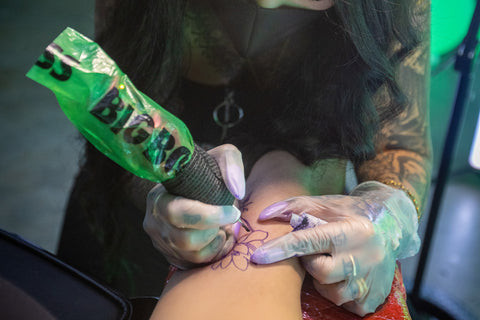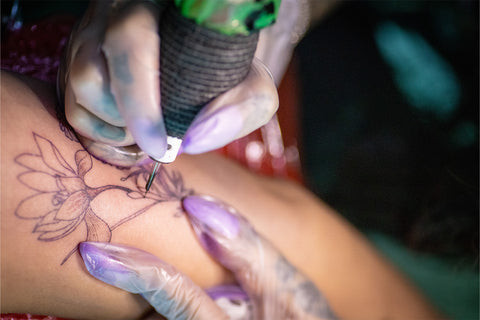How is a tattoo done? The process of getting inked involves several crucial steps, from selecting a design to aftercare, and tattooat.com is here to guide you through each stage ensuring a safe and satisfying experience. Understanding these steps empowers you to make informed decisions, resulting in a stunning piece of body art. Discover the artistry, preparation, and healing involved, and start your tattoo journey informed about skin art, body modification and permanent designs.
1. Conceptualizing Your Tattoo Design
Before you even think about needles and ink, deciding on the perfect tattoo is essential. This isn’t a decision to take lightly; it’s a piece of art you’ll carry with you forever.
- Meaning and Personal Connection: Your tattoo should resonate with you personally. Consider symbols, images, or quotes that hold significance in your life.
- Research and Inspiration: Explore different styles, artists, and designs. Websites like tattooat.com offer a vast gallery of ideas. Social media platforms can be helpful, but make sure to confirm an artist’s social media photos with others who have gotten tattoos from them.
- Placement Matters: Think about where you want your tattoo. Different body parts have different pain levels, visibility, and how the design will flow with your body.
2. Choosing the Right Tattoo Artist
The skill and experience of your tattoo artist are paramount. They’re not just applying ink; they’re bringing your vision to life.
- Specialization: Different artists specialize in different styles, like realism, traditional, watercolor, or geometric. Find someone whose style aligns with your design.
- Portfolio Review: Examine their portfolio closely. Look for clean lines, solid color saturation, and overall quality.
- Consultations: Schedule consultations with potential artists. This allows you to discuss your design, ask questions, and gauge their professionalism.
- Hygiene and Safety: Ensure the studio is clean and uses sterile equipment. Don’t hesitate to ask about their sterilization procedures.
 tattoo artist consultations
tattoo artist consultations
3. Ensuring a Legitimate Tattoo Shop
The environment where you get tattooed is as important as the artist performing the work. A reputable shop adheres to strict hygiene and safety standards.
- Cleanliness is Key: The shop should be spotless, with no visible dirt or clutter.
- Sterilization Equipment: Look for an autoclave, a machine used to sterilize equipment. This is essential for preventing infections.
- Licensing and Certification: Ensure the shop and artist have the necessary licenses and certifications required by your state.
- Single-Use Needles: Needles should always be single-use and disposed of properly after each client.
- Proper Sanitation Protocols: According to hygiene standards, tattoo parlors need to have proper sanitation protocols in place to prevent infection.
4. Collaborating on Design and Size Adjustments
Your tattoo artist might suggest adjustments to your design for various reasons. Be open to collaboration.
- Size and Placement Considerations: Some designs may need to be resized to fit properly on your chosen body part.
- Longevity: Artists may advise against certain intricate details that might fade or blur over time.
- Artistic Interpretation: Trust your artist’s expertise to translate your vision into a tattoo that will look great and last.
- Open Communication: Don’t be afraid to voice your concerns or preferences. It’s your tattoo, after all.
5. Preparing Your Skin for the Stencil
Before the tattooing begins, your skin needs to be prepped to ensure a clean and sterile canvas.
- Shaving: The area will be shaved to remove any hair that could interfere with the tattooing process.
- Cleansing: The skin will be thoroughly cleaned with an antibacterial soap or solution to remove dirt and bacteria.
- Stencil Application: The stencil, a temporary transfer of your design, will be applied to your skin. This allows you to see exactly how the tattoo will look.
- Final Approval: Before proceeding, carefully review the stencil placement and size. This is your last chance to make changes.
6. Outlining the Tattoo
The outline is the foundation of most tattoos, providing structure and definition.
- Needle Selection: Artists use specific needles for outlining, typically smaller and more precise.
- Steady Hand: A skilled artist will create clean, crisp lines, following the stencil carefully.
- Pain Level: Outlining can be more intense than shading for some people, as it often involves more concentrated pressure.
- Breaks When Needed: Don’t hesitate to ask for a break if you need one.
 Tattoo artist completing an outline
Tattoo artist completing an outline
7. Adding Color and Shading
Once the outline is complete, the artist will add color and shading to bring your tattoo to life.
- Color Palette: Discuss your desired color palette with your artist beforehand.
- Shading Techniques: Different shading techniques can create depth, dimension, and visual interest.
- Needle Configuration: Artists often switch to larger needle groupings for shading, allowing them to cover more area efficiently.
- Layering: Multiple layers of ink may be needed to achieve the desired color saturation and effect.
8. Wrapping and Aftercare Instructions
Proper aftercare is crucial for ensuring your tattoo heals correctly and maintains its vibrancy.
- Cleansing: Gently wash the tattooed area with mild soap and water to remove any blood or ink residue.
- Drying: Pat the area dry with a clean paper towel. Avoid using a cloth towel, as it can harbor bacteria.
- Ointment Application: Apply a thin layer of tattoo-specific ointment or moisturizer to keep the area hydrated.
- Wrapping: Your artist will wrap the tattoo with a sterile bandage or medical-grade adhesive film to protect it from infection.
- Detailed Instructions: Your artist will provide you with specific aftercare instructions tailored to your tattoo and skin type. Follow these instructions carefully.
9. Taking Great Care of Your New Tattoo
The first few weeks after getting a tattoo are critical for the healing process.
- Keep it Clean: Wash the tattoo 2-3 times a day with mild soap and water.
- Moisturize Regularly: Apply a thin layer of ointment or moisturizer several times a day to prevent the tattoo from drying out and scabbing.
- Avoid Sun Exposure: Protect your tattoo from direct sunlight, as it can cause fading.
- No Scratching or Picking: Resist the urge to scratch or pick at any scabs that may form. This can damage the tattoo and increase the risk of infection.
- Stay Hydrated: Drinking plenty of water helps keep your skin hydrated, which is essential for healing.
Understanding Tattoo Pain
Pain is a common concern for those considering a tattoo. While it’s subjective, understanding the factors involved can help manage expectations.
- Placement: Bony areas (ribs, ankles) and areas with nerve endings (neck, inner thighs) tend to be more sensitive.
- Size and Detail: Larger, more detailed tattoos take longer and can be more painful.
- Individual Tolerance: Pain tolerance varies greatly from person to person.
- Numbing Creams: Over-the-counter or prescription numbing creams can help reduce pain.
- Breaks: Don’t hesitate to ask for breaks during the session.
Different Tattoo Styles Explained
The world of tattoos is diverse, with a style to suit every taste.
- Traditional (Old School): Bold outlines, limited color palettes, and classic imagery like roses, anchors, and eagles.
- Realism: Highly detailed and lifelike depictions of people, animals, or objects.
- Watercolor: Soft, flowing colors that mimic the look of watercolor paintings.
- Geometric: Precise lines and shapes that create intricate patterns.
- Tribal: Bold, graphic designs often inspired by indigenous cultures.
- Blackwork: Tattoos done entirely in black ink, often using bold lines and geometric shapes.
- Neo-Traditional: A modern take on traditional tattooing, with brighter colors, more detail, and a wider range of imagery.
The Importance of Aftercare Products
Choosing the right aftercare products is essential for proper healing.
- Tattoo-Specific Ointments: These are designed to keep the skin hydrated without clogging pores.
- Fragrance-Free Soaps: Harsh soaps can irritate the skin and slow down healing.
- Sunscreen: Protects the tattoo from fading and sun damage.
- Avoid Petroleum-Based Products: These can trap moisture and increase the risk of infection.
According to research from Portland State University’s Art Department, in July 2025, moisturizing the area with the right skin protectant or lotion is very important. If your tattoo prematurely scabs or flakes, you can lose the pigments and damage your design.
Addressing Common Tattoo Concerns
It’s normal to have questions and concerns before getting a tattoo.
- Infection: While rare, infections can occur. Signs include excessive redness, swelling, pus, and fever. Seek medical attention if you suspect an infection.
- Allergic Reactions: Allergic reactions to tattoo ink are also rare but possible.
- Fading: Tattoos can fade over time due to sun exposure and natural aging. Proper aftercare and touch-ups can help minimize fading.
- Scarring: Scarring is usually minimal with a skilled artist, but it can occur if the tattoo is not properly cared for or if you’re prone to scarring.
- Tattoo Removal: If you later regret your tattoo, laser removal is an option.
Tattoo Trends in the USA
The tattoo scene in the USA is constantly evolving.
- Micro Tattoos: Tiny, minimalist designs that are often placed in discreet locations.
- White Ink Tattoos: Subtle tattoos done with white ink.
- Botanical Tattoos: Designs featuring flowers, leaves, and other plant life.
- Geometric Mandalas: Intricate geometric designs with spiritual significance.
- Blackout Tattoos: Large areas of skin covered entirely in black ink.
Here’s a quick look at some current tattoo trends:
| Trend | Description | Popular Locations |
|---|---|---|
| Micro Tattoos | Tiny, minimalist designs | Wrists, ankles, fingers |
| White Ink | Subtle, delicate tattoos | Ribs, collarbones, behind ear |
| Botanical | Floral and plant-inspired designs | Arms, legs, back |
| Geometric | Intricate patterns and shapes | Back, chest, arms |
The Cultural Significance of Tattoos
Tattoos have a rich history and cultural significance dating back thousands of years.
- Ancient Practices: Tattoos have been used for centuries for various purposes, including rituals, identification, and adornment.
- Symbolism: Different cultures have different tattoo symbols and meanings.
- Modern Expression: Today, tattoos are often used as a form of self-expression, creativity, and personal storytelling.
- Evolving Perceptions: Tattoo acceptance has grown significantly in recent years, with more people embracing body art.
Finding Inspiration on tattooat.com
tattooat.com is your go-to resource for all things tattoo-related.
- Extensive Design Gallery: Browse thousands of tattoo designs in various styles and categories.
- Artist Directory: Find talented tattoo artists in your area.
- Aftercare Guides: Learn how to properly care for your new tattoo.
- Trend Spotting: Stay up-to-date on the latest tattoo trends.
- Community Forum: Connect with other tattoo enthusiasts and share your experiences.
Address: 1825 SW Broadway, Portland, OR 97201, United States.
Phone: +1 (503) 725-3000.
Website: tattooat.com.
Creating a Tattoo-Friendly Lifestyle
Integrating your tattoo into your lifestyle involves a few key considerations.
- Clothing Choices: Certain clothing may rub against your tattoo and cause irritation, especially during the healing process.
- Sun Protection: Sunscreen is essential for preventing fading.
- Exercise: Avoid excessive sweating and friction in the tattooed area during the initial healing period.
- Swimming: Avoid swimming in pools or oceans until your tattoo is fully healed, as these can expose it to bacteria and chemicals.
Preparing for Your First Tattoo Appointment
Preparation is key to a smooth and enjoyable tattoo experience.
- Get Plenty of Sleep: Being well-rested will help you better tolerate the pain.
- Eat a Good Meal: A full stomach will help keep your blood sugar stable.
- Stay Hydrated: Drink plenty of water in the days leading up to your appointment.
- Avoid Alcohol and Blood Thinners: These can increase bleeding and make the tattooing process more difficult.
- Wear Comfortable Clothing: Choose clothing that won’t rub against the tattooed area.
- Bring Entertainment: Bring a book, music, or a friend to help distract you during the session.
Navigating Tattoo Touch-Ups
Touch-ups are sometimes necessary to keep your tattoo looking its best.
- Fading: Tattoos can fade over time due to sun exposure, skin aging, and other factors.
- Ink Drop-Out: Sometimes, ink may not fully take in certain areas, resulting in patchy spots.
- Minor Imperfections: Small imperfections can be corrected with a touch-up.
- Artist Recommendation: Your artist may recommend a touch-up after the initial healing period to ensure the tattoo looks perfect.
Understanding Tattoo Ink and Pigments
Tattoo ink is a complex mixture of pigments and carriers.
- Pigment Types: Different pigments are used to create different colors.
- Carrier Solutions: Carriers are used to suspend the pigments and transport them into the skin.
- Ink Safety: Choose artists who use high-quality, reputable tattoo inks that are less likely to cause allergic reactions.
- Vegan Inks: Vegan tattoo inks are available for those who prefer cruelty-free products.
10 FAQs About How Tattoos Are Done
-
How is the design transferred to the skin?
The design is transferred to the skin using a stencil. The artist creates a stencil of the design and then applies it to the skin using a special transfer solution.
-
What type of needles are used for tattooing?
Tattoo needles come in various sizes and configurations, depending on the type of work being done. Round needles are used for outlining, while magnum needles are used for shading and filling.
-
How deep does the needle go into the skin?
The needle typically penetrates about 1-2 millimeters into the dermis, the second layer of skin.
-
What is the buzzing sound during tattooing?
The buzzing sound is the sound of the tattoo machine rapidly moving the needle up and down.
-
How long does a tattoo take to heal?
A tattoo typically takes 2-4 weeks to heal completely, but it can vary depending on the size and location of the tattoo.
-
Can I shower after getting a tattoo?
Yes, you can shower after getting a tattoo, but avoid soaking the tattoo for extended periods.
-
What should I avoid during the healing process?
Avoid sun exposure, swimming, scratching, and wearing tight clothing over the tattoo during the healing process.
-
How do I choose the right tattoo artist?
Research artists’ portfolios, read reviews, and schedule consultations to find an artist whose style and expertise match your vision.
-
What are the risks of getting a tattoo?
The risks of getting a tattoo include infection, allergic reactions, scarring, and tattoo regret.
-
How can I minimize the pain of getting a tattoo?
You can minimize the pain by choosing a less sensitive area, using numbing cream, taking breaks, and staying relaxed.
Ready to explore the world of tattoos? Visit tattooat.com today to discover stunning designs, find talented artists, and learn everything you need to know about getting inked!
